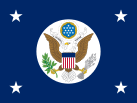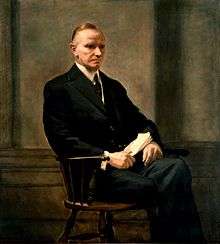Frank B. Kellogg
| Frank Kellogg | |
|---|---|
 | |
| 45th United States Secretary of State | |
|
In office March 5, 1925 – March 28, 1929 | |
| President |
Calvin Coolidge Herbert Hoover |
| Preceded by | Charles Evans Hughes |
| Succeeded by | Henry L. Stimson |
| United States Ambassador to the United Kingdom | |
|
In office January 14, 1924 – February 10, 1925 | |
| President | Calvin Coolidge |
| Preceded by | George Harvey |
| Succeeded by | Alanson B. Houghton |
| United States Senator from Minnesota | |
|
In office March 4, 1917 – March 4, 1923 | |
| Preceded by | Moses E. Clapp |
| Succeeded by | Henrik Shipstead |
| Personal details | |
| Born |
Frank Billings Kellogg December 22, 1856 Potsdam, New York, U.S. |
| Died |
December 21, 1937 (aged 80) St. Paul, Minnesota, U.S. |
| Political party | Republican |
| Spouse(s) | Clara Cook |
| Awards | Legion of Honour |
| Signature |
|
Frank Billings Kellogg (December 22, 1856 – December 21, 1937) was an American lawyer, politician and statesman who served in the U.S. Senate and as U.S. Secretary of State.[1] He co-authored the Kellogg–Briand Pact, for which he was awarded the Nobel Peace Prize in 1929.[2]
Early life and career
Kellogg was born in Potsdam, New York on December 22, 1856. His family moved to Minnesota in 1865.[3]
Kellogg was a self-trained lawyer who began practicing law in Rochester, Minnesota, in 1877. He served as city attorney of Rochester 1878–1881 and county attorney for Olmsted County, Minnesota, from 1882 to 1887. He moved to St. Paul, Minnesota, in 1886.[3]
In 1905, Kellogg joined the federal government when Theodore Roosevelt asked Kellogg to prosecute a federal antitrust case.[4] In 1906, Kellogg was appointed special counsel to the Interstate Commerce Commission for its investigation of E. H. Harriman. In 1908, he was appointed to lead the federal prosecution against Union Pacific Railroad, under the Sherman Antitrust Act.[5][6][7] His most important case was Standard Oil Co. of New Jersey v. United States, 221 U.S. 1 (1911). Following this successful prosecution, he was elected president of the American Bar Association (1912–1913).
In 1907 he was elected as a Compatriot of the Minnesota Society of the Sons of the American Revolution.[8]
United States Senate
In 1916, Kellogg was elected as a Republican to the United States Senate from Minnesota and served from March 4, 1917 to March 4, 1923 in the 65th, 66th, and 67th Congresses. During the ratification battle for the Treaty of Versailles, he was one of the few Republicans who supported ratification. He lost his re-election bid in 1922 and, in 1923, he was a delegate to the Fifth International Conference of American States at Santiago, Chile.[3]
Ambassador to Great Britain
In 1924, he was appointed by President Calvin Coolidge as Ambassador Extraordinary and Plenipotentiary to Great Britain,[9] serving from January 14, 1924 to February 10, 1925. He succeeded George Brinton McClellan Harvey who served under Warren G. Harding and was succeeded by Alanson B. Houghton so that Kellogg could assume the role of Secretary of State.[3]
Secretary of State

From 1925 until 1929, he served as the United States Secretary of State in the Cabinet of President Coolidge.[10] In 1928, he was awarded the Freedom of the City in Dublin, Ireland and in 1929 the government of France made him a member of the Legion of Honour.[3]
As Secretary of State, he was responsible for improving U.S.–Mexican relations and helping to resolve the long-standing Tacna–Arica controversy between Peru and Chile. His most significant accomplishment, however, was the Kellogg–Briand Pact, signed in 1928. Proposed by its other namesake, French foreign minister Aristide Briand, the treaty intended to provide for "the renunciation of war as an instrument of national policy." He was awarded the 1929 Nobel Peace Prize in recognition.[3][11][12]
He was associate judge of the Permanent Court of International Justice from 1930 to 1935.[13][14][15][16]
Personal life
In 1886, Kellogg was married to Clara May Cook (1861–1942), the daughter of George Clinton Cook (1828–1901) and Elizabeth (née Burns) Cook (1838–1908).[17]
In 1880, he became a member of the masonic lodge Rochester No. 21 where he received the degrees of freemasonry on April 1, April 19, and May 3.[18]
He died from pneumonia, following a stroke, on the eve of his 81st birthday in St. Paul.[1] He was buried at the Chapel of St. Joseph of Arimathea in Washington National Cathedral, Washington, D.C.[3]
Legacy
In 1937, he endowed the Kellogg Foundation for Education in International Relations at Carleton College, where he was a trustee.[19] His house in St. Paul, the Frank B. Kellogg House was listed as a National Historic Landmark in 1976.[20]
The following were named in his honor:
- Kellogg Boulevard in downtown Saint Paul.[21]
- Kellogg Middle School in Shoreline, Washington and Rochester, Minnesota, as was Frank B. Kellogg High School (closed 1986) in Little Canada, Minnesota which had been a part of Roseville School District 623.
- A Liberty ship, the SS Frank B. Kellogg
Papers
Frank B. Kellogg's papers are available for research use at the Minnesota Historical Society. They include correspondence and miscellaneous papers, State Department duplicates, news clippings scrapbooks, awards, floor plans, honorary degrees, maps, memorials and memoranda.[22]
See also
References
- Notes
- 1 2 "Frank B. Kellogg Dies At Age Of 81 [sic]. Winner of Nobel Peace Prize for Pact Outlawing War, Ex-Secretary of State". New York Times. December 22, 1937. Retrieved December 16, 2014.
Frank B. Kellogg, former World Court judge and Secretary of State, died at 7:28 P. M., Guy Chase, his law partner, announced tonight.
- ↑ "The Nobel Peace Prize 1929". Nobelprize.org. Retrieved October 6, 2011.
- 1 2 3 4 5 6 7 "KELLOGG, Frank Billings - Biographical Information". bioguide.congress.gov. Biographical Directory of the United States Congress. Retrieved May 13, 2017.
- ↑ "Frank B. Kellogg - Biographical". nobelprize.org. Retrieved December 14, 2014.
- ↑ "TAFT DECLINES COMMENT.; F.B. Kellogg, in Conference with Candidate, Also Silent Now". The New York Times. July 23, 1908. Retrieved May 13, 2017.
- ↑ "Article 2 -- No Title". The New York Times. November 21, 1909. Retrieved May 13, 2017.
- ↑ Neubeck, Deborah Kahn. "Collection Finding Aids, Frank B. Kellogg chronology". mnhs.org. Retrieved December 14, 2014.
- ↑ https://www.ancestry.com/interactive/2204/32596_242110-00195?pid=202616&backurl=https://search.ancestry.com/cgi-bin/sse.dll?_phsrc%3DWOu109%26_phstart%3DsuccessSource%26usePUBJs%3Dtrue%26indiv%3D1%26db%3DSARMemberApps%26gss%3Dangs-d%26new%3D1%26rank%3D1%26msT%3D1%26gsfn%3Dfrank%26gsfn_x%3D1%26gsln%3Dkellogg%26gsln_x%3D1%26MSAV%3D1%26uidh%3Dvt7%26pcat%3D39%26fh%3D0%26h%3D202616%26recoff%3D%26ml_rpos%3D1&treeid=&personid=&hintid=&usePUB=true&_phsrc=WOu109&_phstart=successSource&usePUBJs=true
- ↑ "2,000 NOMINATIONS MADE BY COOLIDGE; List Is Headed by Frank B. Kellogg for Ambassador to Britain". The New York Times. December 11, 1923. Retrieved May 13, 2017.
- ↑ "SACASA PROTESTS KELLOGG'S COURSE; Said to Have Threatened in Message to Rouse Latin America Against Us. WILL KEEP UP THE FIGHT He Promptly Denies Story That He Is Giving Up in Face of Our Opposition". The New York Times. January 15, 1927. Retrieved May 13, 2017.
- ↑ Times, Wireless To The New York (November 29, 1930). "KELLOGG TO GO TO OSLO.; But Nobel Peace Prize Winner Is Uncertain When He Can Pay Visit". The New York Times. Retrieved May 13, 2017.
- ↑ Times, Wireless To The New York (November 27, 1929). "Kellogg Gets Honorary Degree at Oxford; Outstanding Candidate for Nobel Peace Prize". The New York Times. Retrieved May 13, 2017.
- ↑ Photo, Manley O. Hudson, Bemis Professor Of International Law, Harvard Law School times Wide World (October 12, 1930). "WHO'S WHO OF THE JUDGES ELECTED TO WORLD COURT; FRANK B. KELLOGG". The New York Times. Retrieved May 13, 2017.
- ↑ Kellogg, Frank B. (December 24, 1933). "THE ROAD TO PEACE". The New York Times. Retrieved May 13, 2017.
- ↑ Times, Special To The New York (February 27, 1934). "CABINET MEMBERS EXPLAIN NEW DEAL; Cummings and Roper Urge at Rollins College Education as Aid to Government. BOTH RECEIVE DEGREES College at Founders' Day Celebration Honors Frank B. Kellogg for World Peace Efforts". The New York Times. Retrieved May 13, 2017.
- ↑ Installation ceremony of Frank B. Kellogg at Permanent Court of International Justice, The Hague (1930), at YouTube.
- ↑ "MRS. F. B. KELL0GG, DIPLOMAT'S WIDOW; Was Hostess for Her Husband Co-Author of Peace Pact and Ex-Secretary of State DIES AT ST. PAUL HOME Aided Mrs. Coolidge at White House FetesmCouple Marked 50th Anniversary in 1936". The New York Times. October 3, 1942. Retrieved May 13, 2017.
- ↑ Denslow, William R. (1957). "10,000 Famous Freemasons". The Phoenixmasonry Masonic Museum and Library. Macoy Publishing & Masonic Supply Co., Inc. Retrieved November 10, 2014.
- ↑ Times, Special To The New York (June 8, 1937). "CARLETON COLLEGE GETS $500,000 GIFT; Frank B. Kellogg Establishes Unit for Study of International Relations". The New York Times. Retrieved May 13, 2017.
- ↑ "Frank B. Kellogg House". National Historic Landmark summary listing. National Park Service. Archived from the original on April 3, 2008. Retrieved January 8, 2008.
- ↑ Millett, Larry (2007). AIA Guide to the Twin Cities: The Essential Source on the Architecture of Minneapolis and St. Paul. Minnesota Historical Society Press. p. 142. ISBN 0-87351-540-4.
- ↑ Frank B. Kellogg Papers
- Sources
- Bryn-Jones, David. Frank B. Kellogg: A Biography. New York, G. P. Putnam’s Sons, 1937. (Reprinted in 2007: ISBN 978-1-4325-8982-0)
- Ellis, Lewis Ethan. Frank B. Kellogg and American foreign relations, 1925-1929. New Brunswick, N.J.: Rutgers University Press, 1961.
- Ferrell, Robert H. Frank B. Kellogg & Henry L. Stimson: The American Secretaries of State and their diplomacy. Cooper Square Publishers, 1963.
- Kellogg, Frank. China's Outstanding Problems, 1925.
Further reading
- Ferrell, Robert H. Frank B. Kellogg; Henry L. Stimson (1963) online
External links
- United States Congress. "Frank B. Kellogg (id: K000065)". Biographical Directory of the United States Congress.
| Wikimedia Commons has media related to Frank B. Kellogg. |
- Eric Weber. "Kellogg, Frank Billings (1856-1937)." MNopedia. Minnesota Historical Society.
- Newspaper clippings about Frank B. Kellogg in the 20th Century Press Archives of the German National Library of Economics (ZBW)
| Party political offices | ||
|---|---|---|
| First | Republican nominee for U.S. Senator from Minnesota (Class 1) 1916, 1922 |
Succeeded by Arthur E. Nelson |
| U.S. Senate | ||
| Preceded by Moses E. Clapp |
U.S. Senator (Class 1) from Minnesota 1917–1923 Served alongside: Knute Nelson |
Succeeded by Henrik Shipstead |
| Diplomatic posts | ||
| Preceded by George Harvey |
United States Ambassador to the United Kingdom 1924–1925 |
Succeeded by Alanson B. Houghton |
| Political offices | ||
| Preceded by Charles Evans Hughes |
United States Secretary of State 1925–1929 |
Succeeded by Henry L. Stimson |
| 65th | Senate: K. Nelson | F.B. Kellogg | House: A.J. Volstead | C.R. Davis | H. Steenerson | C.B. Miller | S. Anderson | F. Ellsworth | T.D. Schall | C. Van Dyke | H. Knutson | E. Lundeen |
| 66th | Senate: K. Nelson | F.B. Kellogg | House: C.R. Davis | H. Steenerson | A.J. Volstead | S. Anderson | F. Ellsworth | T.D. Schall | C. Van Dyke | H. Knutson | W.L. Carss | W. Newton |
| 67th | Senate: K. Nelson | F.B. Kellogg | House: C.R. Davis | H. Steenerson | A. Volstead | S. Anderson | T.D. Schall | H. Knutson | W. Newton | O. Keller | F. Clague | O. Larson |



